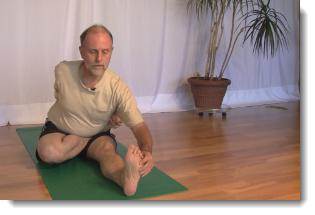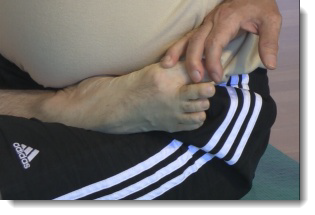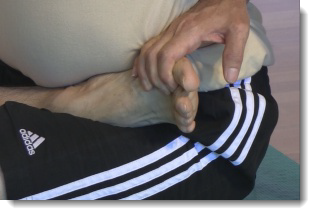Alice came to me with a problem the other day. She is trying to hold on to her toe in Ardha Baddha Padma Pashimottanasana. Every time she gets a hold of her foot, her hand keeps sliding off. It is like her foot is really slippery. Her hand will not stay in place.
Alice has worked her way through the first challenge with this pose. That challenge was to get the heel of her right leg in tight to her left hip with her ankle on top of the thigh and the knee of the right leg resting on the floor.
Alice is now working on the second challenge which is to reach around her back with her right arm and take a hold of the foot of her right leg that is now resting on top of her thigh with the heel pressed into her hip. Gradually her shoulders have become more flexible and her hand has been slowly making progress behind her back towards the foot of her right leg. Just the other day Alice has started to take a hold of her foot.
Now Alice has a new problem. Every time she takes a hold of her big toe her hand gradually slides off of the foot. She can not keep her hand on her foot. Alice is looking for some help on how to keep a hold of her foot and stop her hand from sliding off.
What is Ardha Badha Padma Pashimottasana
This pose is part of the Primary Series of Ashtanga Yoga. It is a seated forward fold with one leg folded into the hip. You do the pose first with the right leg folded into the hip and then you do it with the left leg folded into the hip.
How to do Ardha Badha Padma Pashimottansana
To do this pose you start in Dandasana, which is sitting up straight on the floor with your legs straight out in front of you.
From here you take your right leg and bring the heel into the left hip with the ankle on top of the thigh and the right knee resting on the floor. You hold the little toe side of your right foot with your left hand.
Once the foot is place you reach around your back with your right hand and take a hold of the big toe of the right foot.
After you have a secure grip on your right big toe you bring your torso forward by moving the top of your hips forward towards your extended left leg. As you lower your torso towards your thigh you bring your left hand forward a take a hold of the little toe side of your left foot.
You gaze towards the big toe of your left foot as your lower your torso and head onto your left thigh.
You hold here for five breathes.
What are the challenges with this pose
There are three areas of challenge in this pose.
The first challenge is to get the heel of the right leg into the hip with the ankle on top of the thigh and the knee resting on the floor. To overcome this challenge requires external rotation in the thigh of the right leg.
The second challenge is to take a hold of the right big toe with your right hand reaching around your back. To defeat this challenge requires flexibility in the shoulders. You need to be able to draw the shoulder blades together behind the back.
The third area of challenge is to hold forward a take a hold of the left foot with the left hand and lower the torso towards the leg. This final challenge requires flexibility in the ham strings and hip muscles that allow the hips to tip forward and the torso to come forward and down.
Alice has overcome the first challenge and has the right heel firmly in contact with with her left hip. The ankle of her right foot is on top of her left thigh and her right knee is resting on the floor.
Alice is now working on the second challenge, taking a hold of the right foot with the right hand.
Working on the second challenge
Alice’s arm has been making a slow journey around her back and has only recently reached the foot of her right leg. Now that her hand has reached the foot she is finding to her frustration that her hand keeps sliding off of the foot. It will not stay in place. Every time that she takes a hold of the foot, her hand slides down the foot and off the toes.
Why is Alice’s hand sliding off of her foot?
When you bring the right foot into position on top of the left leg the toes of the foot are pointing towards the back. When Alice’s right hand takes a hold of her right foot it starts to slide towards the end of the toes because the toes are pointing towards her back and there is nothing there to prevent the hand from sliding off of the foot.
Alice could hold the right hand in place with her left hand, but this won’t work for long because her left hand is supposed to take a hold of her left foot when she folds forward.
Alice is having this problem because her shoulders still need to develop some more flexibility. However there is something that Alice can do while here shoulders continue to develop still more flexibility.
What can Alice do to stop her hand sliding off of her foot?
Alice needs to make a hook with her big toe on her right foot. She needs to draw the big toe of her right foot towards her right knee. When she does this she will create a hook at the end of her foot. Her foot will look like a ski jump or the letter “J”. Rather than being a straight line from her ankle to the end of her big toe, now there will be a hook at the end of her foot.
This hook at the end of the foot will prevent her hand from sliding off of her foot. Here is what will happen when Alice takes a hold of her right foot with her right hand now that she has the hook in place. Once the hand starts to slide down the foot towards the toe it will meet resistance and will not be able to slide any further. The hooked big toe of the foot is preventing the hand from sliding any further.
Summary
Once Alice masters this hooked toe technique her foot will no longer be slippery and she will be able to keep holding on to her foot during this pose and move on to the next challenge with this pose.
The next challenge for Alice is to fold forward and take a hold of her left foot with her left hand. Eventually she will be laying her torso on her extended left leg.
Next Step
When you reach a challenging place in a particular pose not just Ardha Badha Padma Pashimottasana talk to your teacher. There may be a slight change that you can make in how you are doing the pose that will make it a lot easier for you to move forward towards the complete expression of the pose.






